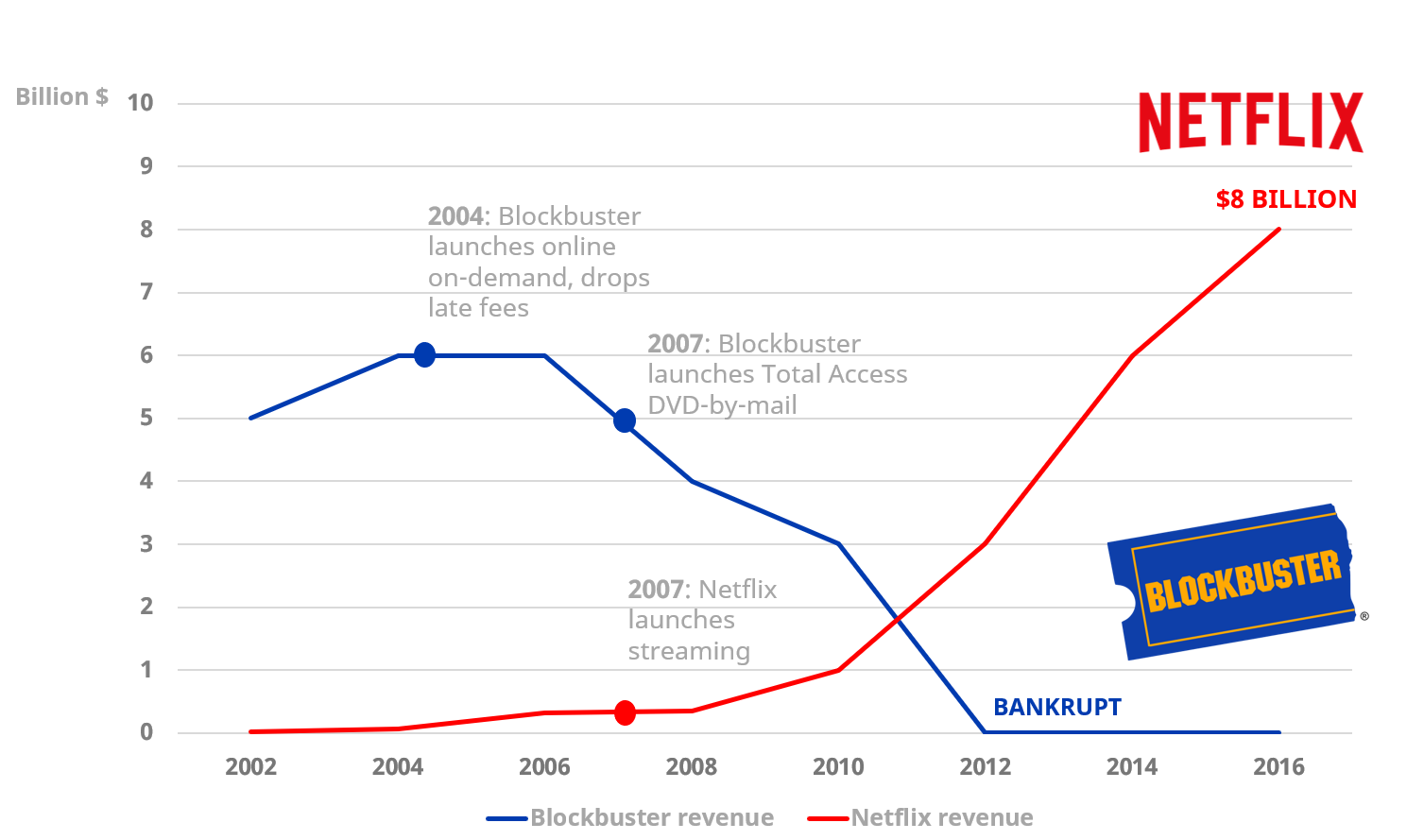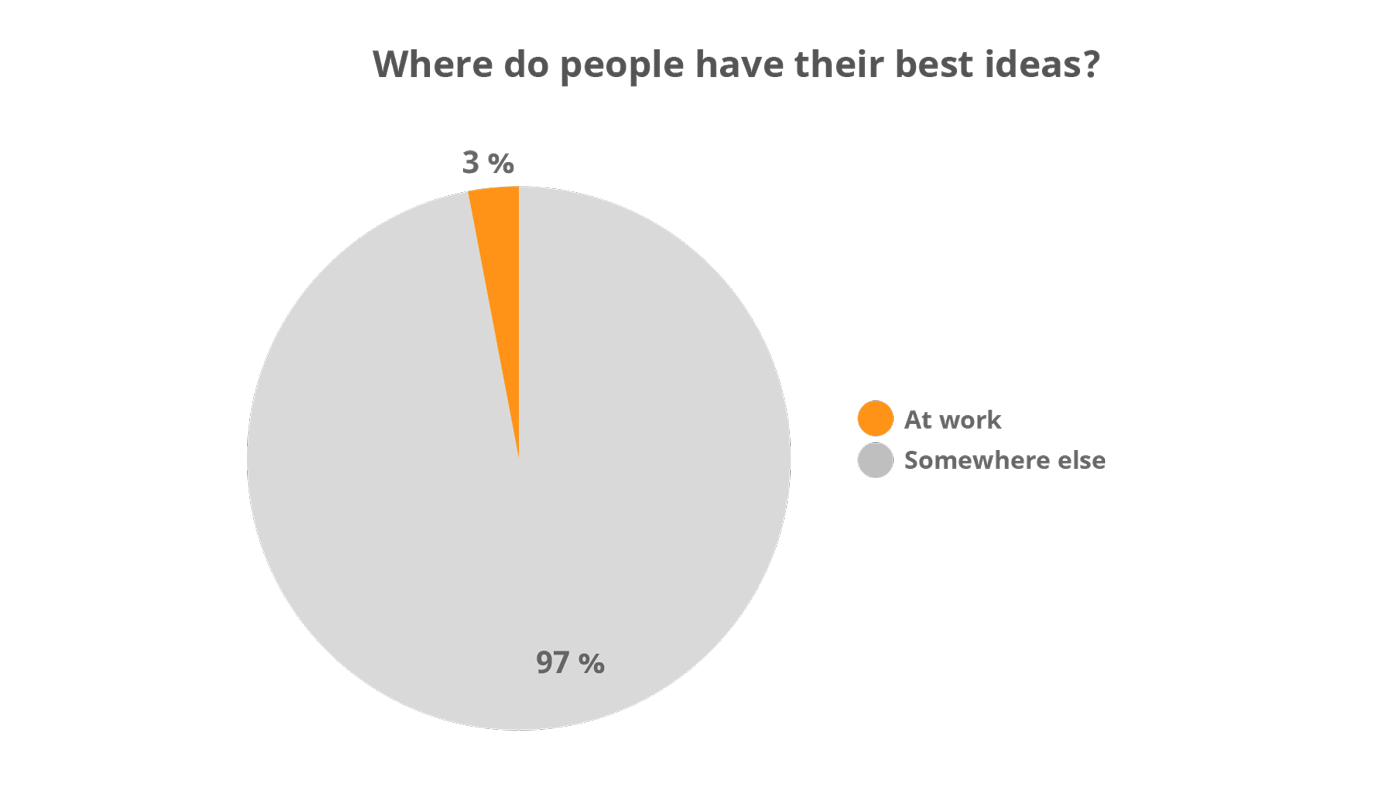Innovative Thinking: Why It's The Skill of the Future
There’s a 25% chance you’ll lose your job to a robot.
In the US, a quarter of all jobs are at high risk of automation, and just with already existing technology. If your job can be done more quickly and accurately by a computer program, then it’s not likely to be around for much longer. What’s more, as technology will continue to develop, that figure will only rise.
However, there’s good news, too. Computers can’t yet think in the creative, flexible ways that us humans can.
This is why so-called “soft skills” like empathic communication and innovative thinking are likely to be so crucial in the next decade, and beyond.
In this article, I'll explore the concept in more detail, and show you 12 actionable ways you and organization can use to get better at it.

What is Innovative Thinking?
The definition of innovative thinking is the ability to come up with new ideas and novel approaches to problems. It is about being creative and flexible.
The definition of innovative thinking is the ability to come up with new ideas and novel approaches to problems.
As technology is moving fast, your ability to be flexible and to adapt to change is crucial if you want to have a successful, or even long, career.
You’ll sometimes hear “innovative thinking” as a synonym for “coming up with new products”, but that’s only one aspect of it. Innovative thinking is in reality creative problem solving, and it’s a skill that you can develop and use at work – whatever your role.
Why Does Innovative Thinking Matter So Much?
Manual jobs are disappearing fast, and the pace of change isn’t slowing down. The trucking industry, for instance, is looking set to be disrupted by autonomous vehicles in the very near future.
But it’s not just manual jobs that are at risk. You might think that highly respected professionals such as doctors and lawyers would be safe, but you’d be wrong.
While we’re likely to see the best lawyers and doctors stick around for quite some time, a huge portion of their colleagues might find themselves out of a job sooner than we might first think.
There have been many advancements in medical AI (artificial intelligence), which could soon be changing the face of medicine, and the technology is ripe to take over a big portion of many law firms and change how law is practiced.

With increasingly advanced AI technology, even creative roles like writing newspaper articles are at risk.
However, there will still be a need for humans to come up with the ideas and edit the articles. Plus, while there’s been great progress in this area, roles involving visual creativity like graphic design and video production aren’t yet looking ripe for automation either.
The common denominator with the jobs that are safe is that those roles typically require a combination of empathy, creativity, and creative problem solving. These just happen to be the central drivers for innovative thinking.
Innovative thinking is a crucial skill, then, for individuals who want to remain competitive in the marketplace. But it’s also vital for companies and organizations.
As mentioned, the pace of innovation and technological change has been accelerating for some time, and it’s been shown again and again that companies need to be innovative to survive and thrive.
We all know the cautionary tales of what Amazon did to bookstores, Netflix did to Blockbuster, and the iPhone did to Nokia, but there’s more to it than just survival. Almost all of the most successful companies of the 21st century are extremely innovative companies. A great showcase for this is simply the list of the most valuable companies in the world, all of which could be characterized as very innovative.
Almost all of the most successful companies of the 21st century are extremely innovative companies. A great showcase for this is simply the list of the most valuable companies in the world, all of which could be characterized as very innovative.
How to Develop Your Innovative Thinking Skills
You might think that some people – and some organizations – are naturally creative or innovative, and that others simply aren’t capable of innovative thinking. Well, that’s not the case.
In reality, these are skills that can be learnt, and developed. Here are some practical ways you can use to develop your creative problem-solving skills, first as an individual, then as part of an organization.
Developing Innovative Thinking Skills – For Individuals
#1: Combine Two Different Ideas
One simple but powerful way to be more creative is to combine two ideas (or products, or services). For example, as everyone probably knows by now, the iPhone was launched in 2007 with Steve Jobs famously explaining that it was a combination of “a widescreen iPod with touch controls, a revolutionary mobile phone, and a breakthrough internet communications device.”
Try It: How could you bring a successful approach from one part of your life (e.g. a hobby) to another (e.g. your work), or from an industry where you’ve previously worked to your current industry?
#2: Generate Lots of Ideas
In the beginning, you should never worry about an idea being “not good enough” or even “silly”. It only takes a minute or two to come up with the next idea. What matters is that you give yourself the creative freedom to brainstorm lots of ideas. That way, the less-good ones can help lead you on to something that’s truly innovative.
Try It: Give yourself a set period of time to list as many ideas as possible. You might want to set a timer for 5 minutes to start with. If you have a hard time getting started at all, just think of what your customers could benefit from.
#3: Set Constraints to Boost Your Creativity
You might think that you’d be at your most creative with a blank canvas and the freedom to do anything you want. However, that usually isn’t the case. Creativity actually thrives with constraints.
Constraints can be anything: time, resources, capabilities, or even the type of ideas you’re focusing on. They can be a key requirement of your business, or simply an artificial limit designed to challenge you think in a more creative manner.
Try It: Are you thinking of launching your own business or side hustle, but struggling to get a loan? Challenge yourself to figure out a way to launch the business for just $50 or $100.
#4: Collect and Manage Your Ideas
It’s crucial to have a system for collecting and managing your ideas. Even if you’re convinced you won’t forget a brilliant idea, you might forget an idea that only seems average – and yet that idea could be just the one you need six months down the line.
Plus, if others are exposed to your idea, it could help trigger their creative juices.
Try It: Take a free trial of Viima, a tool for easily collecting and sorting through your ideas and sharing them with others.
#5: Take Time Away from Your Desk
All too often, inspiration comes when you’re not actively chasing it. Maybe a great idea will strike when you’re in the shower, on a hike, washing dishes, or doing something else completely disconnected from work.
As a matter of fact, only 3% of people’s best ideas come to them while they’re at their desk. Give yourself the space to be innovative by getting away from that desk and letting your mind wander.

Try It: Schedule breaks into your week: time away doesn’t have to be spontaneous and putting it on your calendar means it’s more likely to happen.
#6: Adopt an “Experimental” Mindset
It’s easy for innovation to be stifled if you want to get everything just right from day one. To be a truly innovative thinker, you need to accept the risk of your ideas failing and face the fact that new innovative ideas can’t be planned out on paper without exposing them to the real world.
Come up with a simplified version of one of your ideas, put it into practice and try it as an experiment for a limited period of time without being too attached to the outcome. After that, you’ll usually know exactly what you need to do to iterate on your original idea. And, if it didn’t show any potential, even abandon it completely.
Try It: Pick an idea to try as a 30-day experiment and commit to keeping a daily log of how it goes. If that’s too long, try 14 or 7 days.
Developing Innovative Thinking Skills for Organizations
#1: Encourage Team Members to Come Up with Solo Ideas
Is your team in the practice of brainstorming as a group? You’re not alone, it’s very common.
Yet, this does usually have significant drawbacks, such as encouraging “group think” and crowding out the more introverted members of your team.
Instead, try getting everyone to come up with ideas on their own, get to know everyone else’s ideas, and then meet together to refine and discuss the ideas. You’re guaranteed to get better results quicker.
Try It: Raise a specific problem or challenge for your team and ask them all to come up with 3 ideas prior to your next meeting (you can also share them through Viima), and then get together to discuss the pros and cons and ultimately make a decision.
#2: Always Look for Ways to Get Better
In any organization, it’s easy for a particular process to be used because “that’s the way we’ve always done it.”
However, a method that was the most efficient months or years ago may not be the best one now. Encourage team members to look for ways to accomplish tasks more easily, more quickly, or with fewer resources.
Try It: Pick an established process that’s used a lot and ask your team for their ideas on how to streamline it or otherwise improve it!
#3: Learn from Other Departments, Companies, or Industries
Is your team trying to solve a problem that other teams in your organization have faced? Even if their problem wasn’t identical, you might well be able to learn something from how they tackled it.
Alternatively, you could look outside your company altogether to see what your competitors, or even better, the leading companies in different industries are doing.
Try It: Ask other departments to share their best practices and their lessons learned for a scenario you’re facing.
#4: Get Specific About the Problems Your Customers Face
What are your customers really struggling with? Yes, everyone wants to make more money, save time and be happier, but that’s not enough.
Be specific. Drill down into what they’re truly after, and what’s getting in their way.
Is it a faster horse they are after, or perhaps simply a more convenient way to get from A to B? For instance, perhaps they are struggling to fit everything into their day. You could develop new ways to save them time with your product, and then highlight the ways in which you can save them time in your marketing.
For instance, perhaps they are struggling to fit everything into their day. You could develop new ways to save them time with your product, and then highlight the ways in which you can save them time in your marketing.
Try It: Encourage your customer-facing team members to share the problems, questions, or statements that they’re hearing frequently. Please remember to mention that they don’t need to have the solutions to these problems, it’s just important that they let others know.
#5: Be Intentional About Designing a Creative Work Environment
Your workplace doesn’t need to be filled with bean bags and ping pong tables to be a creative environment.
However, you could deliberately create an innovation culture where ideas are encouraged, implemented, and rewarded. A true culture of innovation isn’t so much about having fun and experimenting but about embracing change and every opportunity to make things better. Here, processes, practices play a huge role, but the work environment is important too. You could, for example, have different spaces in the office that employees can move between when they need to work in a group, or when they need space and quiet to think.
You could, for example, have different spaces in the office that employees can move between when they need to work in a group, or when they need space and quiet to think.
Try It: If everyone’s currently working remotely, think about how you can design a virtual environment for the same. You might let employees work flexible hours, so they can more easily work when they’re at their most creative and productive, or even introduce practices like no-meeting Tuesdays and Wednesdays that allow them to focus on truly creative work.
#6: Build a Diverse Team
When you’re putting together a team, it’s easy to end up with people who are all fairly similar. You might have a team where everyone is roughly the same age, from the same type of background.
But the less diverse your team, the more likely it is that you will struggle to innovate – there won’t be a big enough range of insights, experiences, and expertise to draw on, and it’s often those creative tensions that lead to some of the best ideas.
Try It: Deliberately work on attracting a diverse pool of candidates for your team – and remember that superficial hiring quotas usually aren’t the way to go. To truly succeed, you need to embrace diversity of thinking.
Conclusion
Innovation is now arguably more important than ever, Succeeding at it isn’t always easy, but not trying is even worse.
And while there’s a lot more to it than just Innovative thinking, that’s where it all starts. This could, and likely will, be one of the key skills that make the most difference for you over the next few years.
It can help you reach your goals – and it can help your organization become and remain truly competitive in today’s increasingly more difficult marketplace.
Becoming more creative doesn’t necessarily take a lot of time. Try out some of the ideas above today, and you’ll see the difference.

Want to get better at innovation?
Viima's new The Innovation System is just what you need. Our online-based innovation coaching program combines the most extensive innovation management course with practical tools and templates, as well as peer mentoring to help take what you've learned into practice. Innovation guaranteed, or 100% of your money back.








